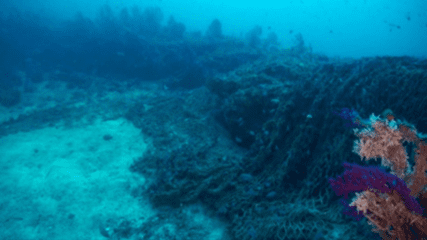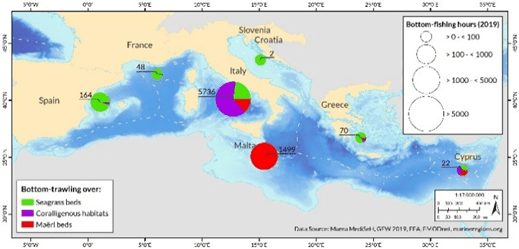Oceana: weak implementation of EU Mediterranean fisheries law leaves sensitive habitats unprotected
Press Release Date: November 30, 2020
Location:
Contact:
Emily Fairless | email: efairless@oceana.org | tel.: +32 478 038 490
Italy is worst-performing Member State, allowing bottom fishing to occur over sensitive habitats and in “protected” areas
Extending the current trawl ban to within 10 nm of the coast or 150 m depth would protect almost the totality of sensitive habitats under the Mediterranean Regulation
Following the release of the European Court of Auditors’ marine policy implementation audit1, Oceana publishes today a comprehensive review2 of the EU Mediterranean fisheries Regulation (1967/2006), showing overall weak implementation, clear infringements by EU Member States and poor enforcement by the European Commission. Our analysis focused on the protection of seagrass, coralligenous and maërl bed habitats and found a total of 7,600 hours of trawling in 2019 over these habitats, with Italy representing two thirds of this, followed by Malta. Data accessed by Oceana also showed very few Fisheries Protected Areas (FPAs) have been established, despite the requirements of the law.
Oceana urges the European Commission and EU Member States to follow a more holistic approach to better protect sensitive Mediterranean habitats by creating broad-scale trawl-free areas in coastal areas, which would deliver a triple win for artisanal low-impact fishers, marine biodiversity and climate resilience.
Vera Coelho, senior director of advocacy for Oceana in Europe, said “Healthy habitats are critical to support thriving fisheries, but our analysis shows that they are not being effectively protected. EU fisheries policy must ensure that sensitive habitats are fully protected from damaging fishing methods, not only in the Mediterranean but everywhere in European coastal waters.”
Seagrass, coralligenous and maërl beds create complex habitats that offer shelter to various marine organisms, especially juvenile fish, enabling them to rest and grow safely. Our analysis shows bottom-trawling occurring over these sensitive habitats, including inside the coastal zone where such fishing is not permitted under the Mediterranean Regulation3. In addition, despite a requirement to designate additional FPAs to protect sensitive habitats, many of the FPAs reported by Member States had in fact already been designated prior to the adoption of the Regulation. Some Italian FPAs, notably in the northern Adriatic Sea, showed no enforcement of rules at all, with illegal trawling occurring inside them. To add to this, the European Commission’s lax enforcement has given EU Member States too much discretion when developing national management plans and often disregarded scientific concerns raised by the Scientific, Technical and Economic Committee for Fisheries (STECF).
Oceana stresses the need to step-up implementation and compliance, especially as the Mediterranean Sea is the most overfished sea in the world. We recommend expanding the current trawl ban from the current 3 nm/ 50 m isobath (protecting 77.6% of habitats) to 10 nm /150 isobath which would protect almost the entirety of such habitats. We also call on the European Commission to assess the effectiveness of FPAs and initiate legal action against EU Member States that have not designated any, or that fail to enforce management rules within them.
 |
 |
| Fishing gear entangled on the coralligenous reef of Fort d’en Moreu (Balearic Islands, Spain) © OCEANA | Bottom fishing hours over protected habitats in 2019 in EU Mediterranean waters © OCEANA |
|
Main findings from Oceana’s report:
|
Background:
The Mediterranean, a global biodiversity hotspot, has some of the most overexploited fish stocks in the world – fishing mortality caused by EU fleets on assessed Mediterranean stocks is 2.4 times greater than those associated with maximum sustainable yield (MSY), the sustainable rate of fishing. Parts of its seabed are also the most bottom trawled on the planet.
Oceana carried out an analysis of the implementation of Regulation EC/1967/2006 on the management measures for the sustainable exploitation of fishery resources in the Mediterranean Sea. We assessed progress by EU Member States in relation to the protection of these habitats, based on national data reported to the EU and on a spatial analysis of fishing activities4 over their known distribution5. Oceana is publishing its report in the context of the release of the EU Court of Auditors’ overarching assessment of EU actions to protect the marine environment, which also highlights implementation issues by EU Member States in the Mediterranean Sea in particular.
# # #
Notes to editors
1 Special Report 26/2020: Marine environment: EU protection is wide but not deep, 26.11.2020 https://www.eca.europa.eu/en/Pages/DocItem.aspx?did=57066
2 “Habitat protection under the Mediterranean Sea Regulation: a missed opportunity?”
3 Regulation EC/1967/2006 prohibits bottom trawling in areas within 3 nautical miles of the coast or with a depth of less than 50 m in the Mediterranean
#MedFish4Ever #Biodiversity2020 #Mediterranean

